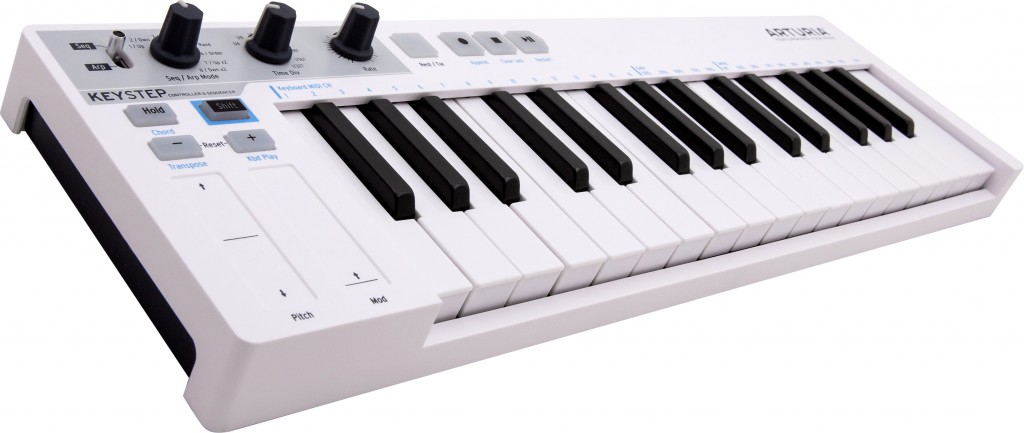There are plenty of hardware step sequencers out there. But now Arturia has a compact entry friendly to keyboardists. This isn’t about dialing up melodies with knobs. It assumes you actually know how to find melodies on some keys.
Clearly building on the success of the BeatStep Pro sequencer hardware, Arturia’s Keystep is a keyboard with both step sequencer and arpeggiator modes. And Arturia has given CDM an exclusive first peek, to share with you.

First, the keyboard itself. It’s a 32-note slim keybed of Arturia’s own making. That keeps the overall body tiny – so this is clearly a mobile keyboard. There’a also built-in (channel) aftertouch.
Pitch bend and mod are provided via capacitive touch strips. So with that combined with aftertouch, you have some control over parameters, though you might still miss the encoders available on the BeatStep Pro.
In a piano-friendly touch, there’s both a pedal input and a HOLD button. “HOLD” isn’t just the equivalent of ‘tie’ – it actually lets you add a sustain pedal by touching a button. In arpeggiator mode, it latches the arpeggiator.
And there are dedicated octave shift keys.

There are two modes.
Step sequencer mode has 8 memory slots.
Each step sequence is 64 steps long, so this isn’t just a one-bar affair. And while ‘step sequence’ is often associated with a mono melody line, here each “step” can contain 8 notes per step, with 8 voices.
You can either tap record and record in real time, or add notes one step at a time. (There’s a dedicated REST/TIE button.) In real-time mode, you can also overdub as you record.
Additionally, you can set and play chords triggering a single note (one finger keyboardist style).
Arpeggiator mode has 8 pattern styles: Up, down, Inclusive, Exclusive, Random, Double up, Double down, Note Order.
Whether you’re using the arpeggiator or the step sequencer, you can adjust Gate and Swing settings (to some fixed values), and time division up to 1/16 notes as duplets or triplets.
You can also extend or shorten a sequence length.
A really cool feature you might easily miss is Keyboard Play Mode. This lets you leave the sequencer playing, but also play the keyboard. You can even set the sequencer and keyboard to separate channels so that each plays a different instrument. (Since there’s only one CV out, that’s always the sequencer.)

I/O:
- Micro USB. (both for USB MIDI with a computer or via adapter iOS device, and for optionalUSB power)
- DC external power.
- Gate and CV outputs for analog gear. (10V gate, 1 volt/octave OR volt->Hz modes on CV out.)
- Mod output, too — assigned to aftertouch, mod strip, or velocity.
- Sync over USB, MIDI, or the Clock port (DIN sync) – or use internal clock.
- MIDI in and out (via the ever-more-popular minijack port).
- DIN sync (for both arp and sequencer mode) gives you 1PPS, 2PPQ, 24PPQ DIN and 48PPQ sync with hardware.
Like the BeatStep Pro, the Keystep (with external power) runs standalone, too, so you can use it with hardware instruments and leave the computer at home.
It looks like another huge hit from Arturia to me. There’s still clearly lots of room for the BeatStep Pro. Those pads make certain features more immediate, you do have dedicated access to three parts, and it’s nice having encoders.
But the Keystep gets points for cleverness for “keyboard play mode” and making keyboard arpeggiations and sequencing easily playable, plus the usual Arturia combo of both CV and MIDI.
We’ll have a hands-on with them in person on their new stuff in a short while, so let us know if you have questions.
Availability: Spring.
Pricing: 119€ (excl. VAT) / US$149.
http://www.arturia.com/products/keystep